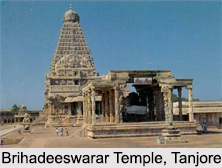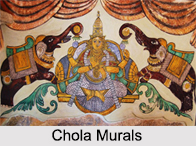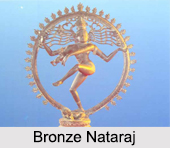 The Chola dynasty was one of the longest ruling dynasties in the history of Southern India, they utilised their prodigious wealth earned through their extensive conquests in building long-lasting stone temples and exquisite bronze sculptures. The Chola art and architecture had the influence of the Pallavas and other contemporary art and architecture schools, which in turn helped them to elevate the Dravidian form to greater heights. Discussed elaborately below are the various forms of Chola art and architecture.
The Chola dynasty was one of the longest ruling dynasties in the history of Southern India, they utilised their prodigious wealth earned through their extensive conquests in building long-lasting stone temples and exquisite bronze sculptures. The Chola art and architecture had the influence of the Pallavas and other contemporary art and architecture schools, which in turn helped them to elevate the Dravidian form to greater heights. Discussed elaborately below are the various forms of Chola art and architecture.
Art under the Cholas
The Chola art and sculpture styles are similar to that of the Pallavas, the structures in most of the temples were carved from stone and metal. They depict the socio religious ideas of the Chola period, the Nataraj sculpture is world famous not only for its beauty but also for its spiritual meaning. There is a certain kind of spiritual calmness in the sculptural representations of the Vishnu idols in the Vaishanava temples or that of the Alwars. The temples of the Imperial Cholas are covered with exquisite well composed sculptures and frescoes. The artists used the lost wax technique and followed the complete Indian Shilpa Shastra. The sculptures during this period are described as the cultural epitome of Chola period and are the best specimen of Chola art.
 The Cholas excelled the Pallavas in the art of portrait making as well, the beautiful portraits on the walls of the Koranganatha and Nageswarasamy temples exhibit the artistry of the craftsmen of that time. The art of paintings also flourished during their time and thus the figures were painted with much realism. There were paintings on the themes of Puranas painted on the inner walls of the Raja Rajeswara Temple and Gangaikonda Cholapuram Temple and the Nataraj Temple at Chidambaram. A painting believed to be that of Marco Polo is in the Brihadeeswarar Temple at Thanjavur. There is also an imagery of Lord Shiva in the cosmic dance form with the celestial dancers which is also found on the walls of Gangaikonda Cholapuram temple.
The Cholas excelled the Pallavas in the art of portrait making as well, the beautiful portraits on the walls of the Koranganatha and Nageswarasamy temples exhibit the artistry of the craftsmen of that time. The art of paintings also flourished during their time and thus the figures were painted with much realism. There were paintings on the themes of Puranas painted on the inner walls of the Raja Rajeswara Temple and Gangaikonda Cholapuram Temple and the Nataraj Temple at Chidambaram. A painting believed to be that of Marco Polo is in the Brihadeeswarar Temple at Thanjavur. There is also an imagery of Lord Shiva in the cosmic dance form with the celestial dancers which is also found on the walls of Gangaikonda Cholapuram temple.
The Cholas also contributed to the growth of both vocal and instrumental music. Instruments such as kudamula, veena, and flute were used and the devadasis were expert musicians and singers. The classical dance forms of Bharatnatyam and Kathakali acquired its basis from under Chola patronage based on rules of the sage Bharata in Natya Shastra. Dance dramas were also performed on stages during the times of festivities and the Chola kings made endowments to promote the art of dancing. The Cholas also promoted the art of drama and the performers received honours from the Chola kings. There are several inscriptions on the walls of the temples detailing the art and culture of that period. The Chola literature spoke about these glorious cultural aspects of that era.
 Architecture under the Cholas
Architecture under the Cholas
A special feature of the Chola architecture is the purity of the artistic tradition. Built in the early 11th century, the two magnificent temples at Thanjavur and the Gangaikonda Cholapuram in Tiruchirapalli District show the best of Chola art and architecture. The Dravidian feature initiated by the Pallavas acquired the classical forms and features under the Cholas such as gopurams, mandapams and vimanas. Initially, the gopuram features were more prominent but in the later stages, the vimanas took the forefront. The sanctums of the Chola temples were both circular and square in size and the walls of the inner sanctum sanatorium were beautified. On the upper side of the sanctum special vimanas are built with dome shaped sikhara and kalasa which were also there on the top of gopurams. The walls of the passage around the Brihadeeswarar Temple sanctum are covered with panels of exquisite paintings which though faint with time show vivid expression The 108 dance poses of Shiva carved on the inner walls of this temple testify to the heights attained by the Cholas in the field of art and architecture. This temple is known to be the finest creation of Chola craftsmen.
The Cholas have a rich history in art and architecture and their specimens still exist among us either in museums or temples. They have acquired fame not only in India but abroad as well. Their style was unique which gave an impetus to the whole style of temple building.



















